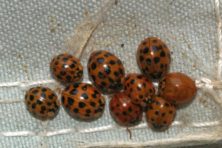Tiny Insect, Big Sound and The Happiness Gene
- Share
- Tweet
- Pin
- Share
• What animal makes the loudest sound relative to its size? It’s not an African elephant, a cicada, or a kind of frog. It’s a tiny, water-dwelling insect called the lesser water boatman. Only 2 mm long, the male boatman emits 99.2 decibels of underwater sound to attract mates. This sound level is comparable to what you hear sitting in the front row before a loud orchestra. It’s even loud enough for humans to hear when walking along a riverbank where these insects are performing underwater. How do they do it? It’s accomplished by the male when it moves its penis across grooves in its abdomen. Make of this what you will, but this finding was presented by scientists at the 2011 conference of the Society for Experimental Biology in Glasgow, Scotland. (Science, July 8, 2011; Sueur et al, 2011, PLoS ONE 6(6):e21089)
• If you own an “outdoor” cat, you know that sometimes it disappears for hours, or sometimes days, at a time. Ever wonder where they go and what they do? Researchers at the University of Illinois and the Illinois Natural History Survey provide some answers. They attached tiny radio transmitters to the collars of 18 pet cats and 24 feral cats, and monitored their activities. Pet cats spent about 80 percent of their time resting and another 17 percent grooming. They spent only 3 percent of their time in high activity pursuits (e.g., hunting). On the other hand, feral cats rested just 62 percent of the time and spent 14 percent, mainly at night, being highly active. Also feral cats roamed much more widely than pet cats, covering as much as 1,351 acres. Pet cats stayed close to home, usually roaming within a five-acre territory. So if your pet outdoor cat is gone for a day or so, it probably isn’t very far away. (Scientific American, August, 2011)
• Some people are happier than others, and genes undoubtedly play a role. Genetic information obtained from 2,574 young adults was compared to the level of satisfaction they expressed. Those with a certain gene called 5-HTT were up to 17 percent more satisfied with their life compared with those having a variant of that gene. Also, a person’s environment can bring about modification of existing genes, a phenomenon known as “epigenetics.” When mothers are chronically stressed (e.g., by anxiety, marital discord, or by physical or mental abuse) during pregnancy, their offspring often show higher rates of mental and/or behavioral disorders. Some researchers believe that stress on the mother results in modifications in genes of the offspring, and these modified genes are responsible for aberrant behavior. An abusive person may have learned that behavior from a parent, but it is also possible that the abusive person is that way because of epigenetic gene changes. It’s also possible that both factors play a role. (The Economist, July 23, 2011; Consumer Reports on Health, August, 2011; other sources)
• There’s a big push at the U.S. National Institutes of Health (NIH) to persuade drug researchers to find new uses for old drugs. When a new drug is marketed for a specific disease by a drug company and it fails to live up to expectations, there’s always the possibility the drug might work to help control or eliminate another kind of disease or condition. For example, thalidomide was used to treat morning sickness in pregnant women before it was discovered that it caused severe birth defects. It was removed from the market, but years later it was discovered to be effective as a treatment for leprosy and multiple myeloma. AZT, the drug used to combat HIV/AIDS, was once used as an anti-cancer drug. Tamoxifen, a drug developed to treat breast cancer, is now being repurposed to help treat bipolar disorder. Repurposing a drug often reflects the fact that the exact mechanism of action at the cellular level is poorly understood – except clinical trials show it works to treat a specific disorder. (Science, June 24, 2011)


